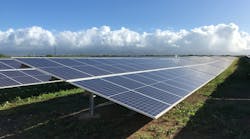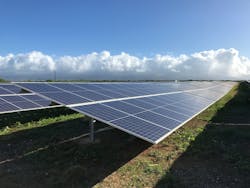WEST LOCH SOLAR PROJECT
Location: Oahu, Hawaii
Project Timeline: The project was dedicated in November 2019.
Number of Photovoltaic Panels: 81,000
Energy Production: 20MW
Solar Construction Company: REC Solar
Owner and Operator: Hawaiian Electric
By 2022, more than 4.4 million solar panels will deliver energy to Hawaiian Electric’s grid. Currently, the utility has nearly 30 grid-scale renewable projects under construction or in planning or regulatory stages. In addition, the utility will soon be issuing a request for proposal (RFP) for grid-scale community solar or community wind projects on all five islands it serves.
“We are a national leader in customer-sited rooftop solar as well as grid-scale projects,” says Jack Shriver, Hawaiian Electric generation project manager. “One in three single-family homes on the island of Oahu has rooftop solar. Across our five islands, we expect to reach 30% renewable portfolio standard (RPS) by the end of this year on the way to 100% by 2045 or sooner, using solar, wind, geothermal, and waste-to-energy primarily — in many cases combined with energy storage.”
For example, Hawaiian Electric recently partnered with the U.S. Navy on the West Loch Solar Project at Pearl Harbor on Oahu. Crews wired more than 81,000 solar panels into more than 100 combiner boxes, using both racked wiring and underground conduit. The combiner boxes were cabled to seven large modular low-voltage inverter/transformer units. The medium-voltage AC output of these transformers was connected via conduit to medium-voltage switchgear and then into a high-voltage step-up transformer and a new substation before tying to the grid.
“The electrical work itself was fairly standardized but large scale,” Shriver says. “The most challenging part of the project was to tune the project control system and integrate it into the grid’s energy management system. As with any first-time project, we have learned a tremendous amount about how these systems work.”
Using the U.S. Navy land for the solar farm was a win-win for both the Navy and Hawaiian Electric. The 102 acres of land, once used as a safety/security buffer zone and for farming, is on the edge of a Navy ordinance depot and cannot be developed with occupied structures for safety considerations.
The U.S. Navy was looking for credit for generating renewable energy on its underutilized land and wanted to secure privately financed capital improvements for its electrical infrastructure on the base. At the same time, Hawaiian Electric was searching for a prime, low-cost site for its first utility-scale solar project to produce the lowest cost renewable energy for its customers. With the West Loch Solar Project now online and generating electricity at 7.5 cents per kilowatt hour, Hawaiian Electric’s customers will save at least $109 million over the project’s 25-year lifespan.
“The advantages include low land and development costs relative to comparable sites, good solar insolation, low potential for future neighboring development, which could impact our PV array, and, of course, the opportunity to assist one of our primary customers, contribute to national security, and benefit all of our customers with low-priced renewable energy,” Shriver says.




